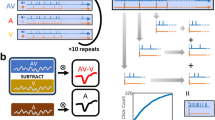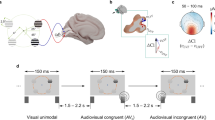In 30 healthy men (age 19–25 years) with normal hearing and 30 men of the same age suffering from complete congenital deafness, we examined peculiarities of the cortical visual evoked potentials, VEPs (photostimulation of the right and left eye by LED flashes, recording from loci O1 and O2). It was found that subjects with auditory deprivation demonstrated significantly shorter (P < 0.05–0.001) peak latencies of the early VEP components (P1, N2, and P2), while peak latencies of the late waves (N2 and P3) were greater (P < 0.05) than the corresponding indices in the control group. Peak-to-peak amplitudes of all VEP components in deaf subjects were about two to three times lower than those in subjects with normal hearing (P < 0.05–0.001). The mean total duration of the VEPs in deaf persons was significantly greater than in the control group (P < 0.05). Therefore, loss of the auditory function in deaf subjects results, due to cross-modal transformations, in substantial modifications of the potentials reflecting perception of the visual signals.
Similar content being viewed by others
References
L. R. Zenkov and M. A. Ronkin, Functional Diagnostics of Nerve Diseases, Meditsina, Moscow (2013).
M. V. Makarenko, V. S. Lizogub, L. I. Yukhymenko, et al., “Age dynamics of sensomotor functions in subjects with auditory deprivation,” Sci. Educ. New Dimens. Nat. Tech. Sci., III (5), 41, www.seanewdim.com, 20-24 (2015).
S. G. Danko, J. A. Boytsova, M. L. Solov’yova, et al., “Event-related brain potentials when conjugating Russian verbs: The modularity of language procedures,” Hum. Physiol., 40, No. 3, 237–243 (2014).
L. A. Renier, I. Anurova, A. G. De Volder, et al., “Preserved functional specialization for spatial processing in the middle occipital gyrus of the early blind,” Neuron, 68, No. 1, 138–148 (2010).
A. N. Shepoval’nikov, “Analysis of the spatial/temporal organization of EEG – pathway for elucidation of the neurophysiological mechanisms of integrative brain activity,” J. Vyssh. Nerv. Deyat., 57, No. 6, 673-683 (2007).
S. D. Yakovleva, “Psychological/physiological aspects of studies of the cognitive working efficiency and approaches for its optimization in children with special educational necessities,” Sci. J. Dragomanov NPU. Correct. Pedagog. Psychol., 19, No. 15, 343-346 (2010).
O. Yokoyama, N. Miura, J. Watanabe, et al., “Right frontopolar cortex activity correlates with reliability of retrospective rating of confidence in shorttermrecognition memory performance,” Neurosci. Res., 68, No. 3, 199–206 (2010).
L. P. Grigor’yeva, “Effects of deprivation-related factors on the perceptive/cognitive development in children,” Vestn. MGL, 16, No. 702, 128-137 (2014).
Author information
Authors and Affiliations
Corresponding author
Rights and permissions
About this article
Cite this article
Yukhymenko, L.I. Cortical Visual Evoked Potentials in Subjects with Auditory Deprivation (Congenital Deafness). Neurophysiology 49, 240–243 (2017). https://doi.org/10.1007/s11062-017-9676-0
Received:
Published:
Issue Date:
DOI: https://doi.org/10.1007/s11062-017-9676-0




